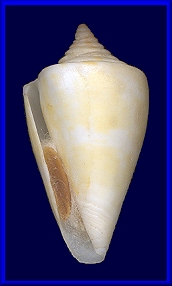|
We shell club
newsletter editors are an enterprising lot and are always on the lookout for
suitable material to publish. Recently
while sorting through the extensive shell collection of Mrs. Norma Carlson of
Leisure City, Florida (a collection acquired by the Jacksonville Shell Club for
disposal) a yellowed manuscript was found. This
manuscript, written by Norma during the late 1970’s, was interesting in that
it detailed her evolving interest in shell collecting beginning in the late
1930’s, when she moved to Miami, and culminated in her main claim to fame in malacological circles - the collection of the first Recent sinistral
(left-handed) cone in the Americas. Equally
intriguing about the manuscript is the fact that this specimen is now in the
collection of Assistant Editor Harry Lee and an image is a permanent part our
club’s web pages. Norma’s article, slightly edited for brevity, is presented
below.
We moved to Miami in July 1939 and found sunshine, flowers, blue sky,
fresh air to breathe, but not many jobs available.
To me Miami Beach was a city of wealthy people, big houses, fantastic
landscaping, sightseeing boats, hotels and apartment buildings.
The beach was a place to picnic, and a place to get away from - with
children's heads full of sand, not to mention the car.
Summer rents were low, and you were warned that the rates would more than
double in November. We planned and
wished to be employed by then, so didn’t worry.
The big trouble was that most houses couldn’t be rented to people with
children. We settled for an
unfinished house, bought basic furniture, and hoped the builder would stay sober
long enough to finish the house before winter.
Well, he didn’t and we stayed through the next January, suffering with
asthma and trying desperately to keep two children warm and healthy.
That winter was cold, so cold that ice formed in the bottom of the
kitchen sink – many times.
 My
next door neighbors were sixtyish, I presumed, and introduced me to sea shells,
miniatures, and all I ever saw were the tiny crabs that they coaxed out of the
shells with a lighted candle, gently played back and forth under each tiny
shell. Their display of shells was
all labeled and neatly placed row after row on black velvet in flat boxes and
covered with cellophane. At the
time I couldn’t be bothered or care less having more important things to do
like cooking and cleaning house, and sewing for which I got paid.
My children took up most of my time. My
next door neighbors were sixtyish, I presumed, and introduced me to sea shells,
miniatures, and all I ever saw were the tiny crabs that they coaxed out of the
shells with a lighted candle, gently played back and forth under each tiny
shell. Their display of shells was
all labeled and neatly placed row after row on black velvet in flat boxes and
covered with cellophane. At the
time I couldn’t be bothered or care less having more important things to do
like cooking and cleaning house, and sewing for which I got paid.
My children took up most of my time.
But this couple, as I recall, were happy and on the go constantly,
to the Keys, wherever that was, and somewhere near Palm Beach and Miami Beach,
and always came home with more crabbed shells, but always miniatures. Now that I know better, I know that they must have spent
hours sifting the high tide lines. Once
my four-year-old son went with them and brought back a shoe box full of beach
shells. The shells finally ended up
in a pile under the back porch steps. Gee,
I wonder what they were. Do you
suppose one could have been a left-handed cone?
I wonder how many boxes of “old” shells there are hidden away in a
closet, or attic, or cellar, or behind the barn, and what rare shell is there
going unnoticed?
Briefly, my shelling experiences didn’t begin until after
Hurricane Donna in 1960 – from beach collecting to wading, to snorkeling, to
diving – then trading.
It was on a visit to Marco, Florida that I found the first
sinistral (left-handed) cone known in the Americas.
My sinistral Conus floridanus
Gabb, 1868 [Florida Cone] (now known as Conus anabathrum Crosse, 1865)
measures 33 mm., has a pink tip, over all yellow color with a white mid band.
It was found while snorkeling in four feet of water, in sand, at Caxambas
Pass, Marco, Florida – April 30, 1967.
A second sinistral Conus
floridanus was found on an exposed mud flat, Buck Key, between Sanibel and
Captiva Islands about 7:30 AM, low tide, in January 1976 by Eugenia I. Wright, a
former Sanibel resident. Both sinistral cones were live collected. Eugenia’s
cone measures 33.1 mm. and is preserved with animal and periostracum.
Editor’s
Comments: A
photograph of Norma’s sinistral Conus
anabathrum appeared on the front page the April, 1971 edition of the
“Mollusk Chaser” – a defunct publication of the South Florida Shell Club,
Inc. where it was proclaimed by the late R. Tucker Abbott as a “unique
scientific find.” To the best of your editorial staff’s knowledge, the two
specimens described above are the only Recent sinistral cones that have ever
been found in North America. Norma's article was also published in "The Mollusk"
Vol. 19, No7., July, 1981 - newsletter of The Greater Miami Shell Club.
|